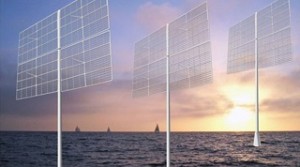Breakthrough in Wind Energy?

Craig: Thanks for this, but aren’t you extremely skeptical? The wind blows charged particles apart from one another? Where do the charged particles come from? How does the wind separate them? And, imagining that this were possible, how does that create a high voltage? Where are they with respect to TRL (Tech Readiness Level)? Btw, can you take a stab at explaining it to me in layman’s terms?Gary: The physics should work if the engineering can be sorted, which looks to be well on the way to happening. The process is rather like the way lightning forms in clouds. I am sure ARPA is not in the habit of funding anything which would break the laws of physics – or for which there is not experimental evidence at lab scale.
Dawn’s talk (from 2009) explains how the process works – if you think how a linear induction motor works, you in effect have charged water droplets being pushed through a magnetic field by the wind and generating electricity in the process – the reverse of the linear induction motor. Sea water is ideal as droplets very easily become electrostatically charged. For a company to continue working on an idea like this for >6 years suggests that progress is being made. The company explains how the concept has been known since the 1960’s, but that it has taken until now to manage the electrical fields in a way which efficiently separates the charge giving net positive energy output.
Craig: Well, I understand the basic concept as it is explained in this video and here’s an article that explains that water droplets do carry a net charge, so I suppose there could be merit to this. Glenn Doty (or any other senior energy engineer/physicist): Can you weigh in on this, please?

I have serious doubts but I suppose it wouldn’t hurt to continue research on it and see if it can be made practical.
The example of a linear induction motor is perhaps a bit misleading as you continue to have actual moving physical parts in a linear motor. It is accurate in that is goes back to the basic principal behind both the motor and the generator of a conductor passing through a magnetic field inducing a current. When you reduce the magnetic field to a fluid rather than a solid magnet the process is called, “Magnitohydrodynamics.” http://www.ijsrp.org/research-paper-0613/ijsrp-p18106.pdf It is a bit of a mouthful but essentially it involves movement of the charged fluid and a conductor. Often the fluid is a high temperature plasma. The process is already used in some power plants as a secondary method of recovering more electricity. https://en.wikipedia.org/wiki/Magnetohydrodynamic_generator Because the only moving part is the fluid it holds the promise of simplicity and low resistance losses. Until now the efficiency is rather low. Arpa has awarded research funds into magnitohydrodynamics with several companies.
Now, about water particles having a charge. This has recently been revealed to be the underlying source of energy behind lightning. http://www.acs.org/content/acs/en/pressroom/newsreleases/2010/august/electricity-collected-from-the-air-could-become-the-newest-alternative-energy-source.html Rather than try and harness the high voltage of lightning it is much more manageable to drain off the charge (like a lightning rod) before the charge builds up to enough potential to create lightning. Like the field of aerial wind turbines there has been some speculation of harnessing the potential charge in humidity using tethers. For now a ground based system seems to make more sense.
A major concern will be lightning strikes burning out the system. The overall efficiency of the system will be another point to watch. On the plus side I wonder if such a system could be used in association with a downdraft solar tower to increase efficiency.